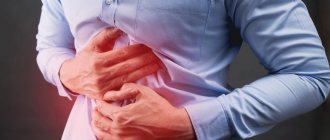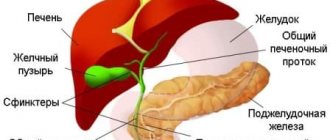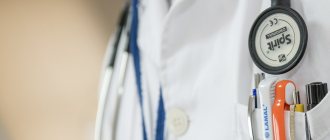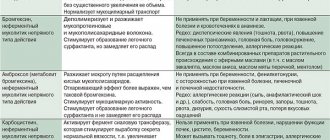- How does JVP manifest itself?
- Why does JVP appear?
- Types of dyskinesia and the nature of its manifestation
- Why is JVP dangerous?
- Diagnostics
- Treatment of biliary dyskinesia
The abbreviation JVP stands for “biliary dyskinesia.” This pathology occurs frequently. According to statistics, it is diagnosed ten times more often in women than in men. When the disease occurs, the process of bile outflow is disrupted. This occurs due to incomplete, increased or delayed contraction of the gallbladder (GB) muscles or biliary sphincters.
For normal muscle contraction, the hormone cholecystokinin is required. It is produced by cells of the duodenum when food enters it. After the release of cholecystokinin, the gallbladder contracts and bile is released into the duodenum. When the muscle tone of the gallbladder is weakened, this process is also disrupted.
How does JVP manifest itself?
You can suspect dyskinesia based on the following signs:
- after eating a meal with a predominance of fatty and spicy foods, pain appears on the right side, which can radiate to the shoulder blade and chest.
- the patient may experience periodic discomfort in the area of the liver and gallbladder: heaviness, aching or acute pain.
- after eating, signs of flatulence appear and stool is disrupted.
- Nonspecific signs include a feeling of bitterness in the mouth, the appearance of plaque on the tongue, and bad breath.
You should know that such symptoms are typical for many gastrointestinal diseases, so only a gastroenterologist can make a final diagnosis after diagnosis.
Symptoms of hypokinetic type JVP
If the contraction process of the gallbladder is disrupted, a large amount of bile will accumulate in it.
If the contraction process of the gallbladder is disrupted, a large amount of bile will accumulate in it. This leads to aching pain in the right hypochondrium, a feeling of fullness in the abdomen, and general well-being worsens. Nausea and vomiting are possible, the feeling of heaviness and discomfort becomes constant and forces the patient to seek medical help.
ADHD develops gradually, and it is important not to delay contacting a specialist in order to get help as quickly as possible. The first symptoms will be heaviness on the right side of the hypochondrium, accompanied by stabbing pains that can radiate to the shoulder blade. The disease can also manifest itself as bloating, in addition, the doctor will pay attention to heartburn and a feeling of bitterness in the tongue. With hypokinetic type VHD, pain in the heart, as well as rapid heartbeat, may occur.
Due to the accumulation of thick bile in the gallbladder, the process will begin to develop rapidly: bile will stagnate in the bile ducts, which will also gradually begin to expand. Since they will begin to put pressure on the liver cells, its functioning will deteriorate, which will create additional problems with digestion. In severe cases, the gallbladder will have to be removed, which will create additional restrictions in the patient’s lifestyle and lead to various inconveniences.
There are primary or secondary dyskinesia. In the first case, it becomes a consequence of an unhealthy diet and a violation of a healthy lifestyle; in the second, it becomes a consequence of cholecystitis or cholelithiasis, as well as any other pathologies of the gallbladder. Dyskinesia of the gallbladder can also occur in children; in many cases it is associated with developmental anomalies.
People over 40 years of age are at risk: sedentary lifestyle. Insufficient physical activity accelerates the likelihood of developing the disease. Even the first symptoms cannot be taken lightly: very often, GIVP leads to the development of cholelithiasis, which can lead to complete blocking of the ducts. This will require surgery and the gallbladder will have to be completely removed.
Why does JVP appear?
Depending on the cause of the pathology, primary and secondary dyskinesia are distinguished:
- Primary ADHD is associated with the anatomical and physiological characteristics of the body and hereditary predisposition. The disease affects young and middle-aged people, including children and adolescents. The main cause of the pathology is a violation of the neuromuscular regulation of the motor function of the gallbladder muscles. This situation occurs against the background of vegetative-vascular dystonia, with increased psycho-emotional stress, and diseases of the nervous system. Most often, the disease is diagnosed in people of thin build, patients with increased excitability of the nervous system, and people whose close relatives have encountered the same problem.
Primary ADHD can develop against the background of endocrine pathologies and age-related hormonal changes. In women, this often occurs during menopause.
Primary dyskinesia is caused by congenital anomalies of the gallbladder. We are talking about its bending, the presence of partitions, weakness of the walls, incorrect location, increased mobility, and an increase in the number of ducts. In this case, a violation of the outflow of bile manifests itself at an early age.
- Secondary dyskinesia accompanies almost all gastrointestinal diseases. It develops with cholecystitis, hepatitis, pancreatitis, enteritis, colitis, gastritis, and diseases of the duodenum. If it is affected, the production of cholecystokinin, which regulates the flow of bile, is disrupted. Dyskinesia is also diagnosed in patients with cholelithiasis. Due to calculi (stones), bile cannot drain normally.
Secondary PVD in women can develop against the background of diseases of the pelvic organs. A similar situation is typical for patients with parasitic infections and allergies.
At increased risk are fans of strict diets, in which the number of meals is reduced and the amount of food is reduced.
Types of dyskinesia and the nature of its manifestation
There are three types of JVP:
- Hypertonic-hyperkinetic. It is quite rare. People with a sensitive nervous system, prone to neuroses and prolonged experiences are susceptible to the disease. Most often, the pathology manifests itself at a young age. The risk of its development increases with a diet with a predominance of spicy foods. The main symptom of hypertensive-hyperkinetic dyskinesia is pain. It can occur after eating or against the background of psycho-emotional stress, and intensify during night sleep. The pain can be quite severe. Their source is the right hypochondrium, from which the pain spreads to other parts of the body: neck, shoulder blade, shoulder and even the lower jaw. The attack can last from several minutes to half an hour.
- Hypotonic-hypokinetic. This variety is much more common than the first. People of middle and mature age are susceptible to the disease. At risk are patients who lead a sedentary lifestyle. Most often, dyskinesia is accompanied by chronic diseases of the gastrointestinal tract. With hypotonic-hypokinetic dyskinesia, bile secretion is slowed down and ductal motility is reduced. This leads to stagnation of bile in the bladder - cholestasis. This condition contributes to a lack of bile acids, which are essential for normal digestion and absorption of nutrients. The disease manifests itself with numerous symptoms. First of all, this is pain, which is dull in nature, accompanied by a feeling of fullness. Patients complain of a feeling of heaviness in the right side. With this form of the disease, discomfort decreases after eating. Due to digestive disorders, nausea and flatulence may occur. Unpleasant symptoms intensify after overeating or eating fatty foods. With a lack of bile acids, intestinal motility is disrupted. This leads to stool upset. The patient may experience both constipation and diarrhea.
- Mixed. With a mixed form of dyskinesia, a predisposition to the disease is combined with other factors that lead to disruption of the outflow of bile.
Reasons for the development of dyskinesia
Consumption of excess fatty foods and irregular eating habits can lead to dyskinesia.
Disturbances in the functioning of the gallbladder and ducts develop over a long period of time. and in many ways they are associated with a violation of a healthy lifestyle. Among the main factors leading to dyskinesia are:
- Irregular meals, lack of breakfast and hot lunch. Most often, if there is no time to eat during the day, in the evening a person tries to catch up and overloads the digestive system.
- Consumption of excess fatty foods. It is fats that are broken down during bile processing, and its deficiency leads to various digestive disorders. These are constipation, diarrhea, other stool disorders, nausea, vomiting and other negative manifestations.
- Frequent consumption of so-called “junk food”: chips, sweet soda, fast food, etc. Such food gives practically nothing to the body, additionally burdens the digestive tract and negatively affects the functioning of the liver and gall bladder.
- Infestation with parasites. Giardia is a particularly common cause of damage to the gallbladder; if infection is detected, it is necessary to first eliminate the cause of the disease, and then deal with the symptoms.
Taking medications. The use of a large number of medications negatively affects the digestive system, the microflora is disrupted, and the load on the liver increases. All this leads to inhibition of the functions of the gallbladder.
Why is JVP dangerous?
The disease does not pose a direct threat to life, but can significantly worsen health. Due to digestive disorders, the body experiences a lack of nutrients and vitamins. A patient with dyskinesia has an increased risk of developing urolithiasis, cholelithiasis, and polyarthritis. Stagnation of bile is harmful to the gallbladder. Against the background of gallstones, cholecystitis develops, stones can form, and the functioning of the pancreas, which is connected to the gallbladder by the duct, is disrupted.
Pain and a feeling of heaviness cause a lot of trouble and interfere with normal performance and rest.
Diagnostics
A gastroenterologist diagnoses the disease. To determine the type of pathology, duodenal intubation technology is used, which involves collecting bile to analyze its composition. The patient is administered magnesium sulfate, which stimulates the secretion of bile. In the hyperkinetic form, bile is released at a rapid pace, which is accompanied by pain. In the hypokinetic form of the disease, discharge begins late, emptying of the gallbladder occurs slowly.
In addition to diagnosis using stimulation of bile secretion, the patient is prescribed laboratory tests, cholecystography, radiography with contrast, ultrasound of the abdominal organs and other hardware procedures. Their task is to evaluate the condition of the gallbladder and ducts to rule out other disorders.
Treatment of biliary dyskinesia
To normalize bile secretion, the patient needs to generally reconsider his lifestyle. This applies to eating habits, maintaining a balance between work and rest. It is necessary to avoid excessive psycho-emotional stress and monitor the health of the nervous and digestive systems.
For hypertensive dyskinesia, a strict diet is prescribed. It is necessary to exclude spicy and fatty foods, alcohol.
Food is taken in small portions 5-6 times a day. Antispasmodics are prescribed to relieve pain. If the pathology is caused by a disease of the nervous system or anxiety, it is recommended to take soothing herbal infusions and sedatives. For biliary dyskinesia of the hypotonic type, the doctor may prescribe allochol, and for biliary dyskinesia of the hypertonic type, rotaverine. There are contraindications, be sure to consult your doctor and read the instructions carefully.
When the secretion of bile is slow, drugs are prescribed that stimulate this process. They are produced on the basis of magnesium sulfate, xylitol and other substances. If the disease is caused by helminthic infestation or an inflammatory process, treatment requires drugs that eliminate the main cause of dyskinesia.
It is important to avoid overeating, long breaks in meals, and excess fats and spices in the diet. An important condition for the normal functioning of the gallbladder is sufficient physical activity. The patient is recommended therapeutic exercises, walks, special exercises to stimulate the flow of bile, and physiotherapy.
Biliary dyskinesia: what is hidden behind this diagnosis?
Abdominal pain, nausea, constipation are the most common symptoms of biliary dyskinesia. We asked Yulia Anatolyevna Saltymakova, a gastroenterologist at the Expert Clinic Tula, to tell us why this disorder occurs and how it can be overcome.
— Yulia Anatolyevna, what is biliary dyskinesia?
— This is a disruption of the functioning of the entire biliary system, and especially the gallbladder. This refers to both hypermotor disorders, i.e. excessive contraction of the gallbladder, and hypomotor disorders - insufficient (weak) contractility of the organ. This disease occurs in both adults and children.
— What are the causes of biliary dyskinesia?
- There are many reasons. The most common is, of course, a nutritional disorder. If we talk about small children (I mean up to three years old), then it can be difficult to feed them. Therefore, quite often parents and grandparents begin to act on the principle: let him eat at least something. And this, as a rule, is something sweet and tasty, that is, fast carbohydrates: juices, buns, sweets, pancakes or sausages. Children love these foods; they are easy to feed. But, unfortunately, this almost always leads to very unfavorable consequences.
If you take older children, their diet often changes when school, sections, and clubs appear. Between extracurricular activities and school, the child may have a quick dry snack and comes home late. And it turns out that he can eat a full meal only after 7 pm. Naturally, his hunger increases during the day, and heavy late meals have a very negative impact, primarily on the functioning of the gallbladder.
It's the same for adults. They say: “We are so busy that we can’t eat properly, so we eat twice a day – at lunch and then at night.” This is where the problems begin.
In addition, the nervous system is closely related to the digestive system. Increased emotional overload, some stressful situations in the family, school - all this negatively affects the functioning of the entire digestive system, and the gallbladder is most susceptible to such factors.
Its functioning is also strongly influenced by the functioning of the intestines. Sometimes constipation and infrequent bowel movements (once every two to three days) can affect the functioning of the gallbladder and cause biliary dyskinesia.
In children, almost all gallbladder diseases (in 99% of cases) are secondary. That is, they are associated, for example, with inflammation in the small intestine, more often in the duodenum. Reactive changes in the pancreas always affect the functioning of the gallbladder, due to the anatomical proximity of their ducts. Therefore, the doctor always strives to get to the bottom of the true cause of the dysfunction of the biliary tract.
The diagnosis of “biliary dyskinesia” may hide diseases of other organs, not just the gallbladder. Therefore, the diagnosis of abdominal pain often requires an extensive examination, which does not always cause understanding on the part of parents.
Read materials on the topic:
Is there a stress vaccine? Congestion again! What to do if your child is constipated? Constipation in adults: looking for causes and getting rid of it Pancreas: the one and only. How to keep her healthy?
— How does biliary dyskinesia manifest in children and adults?
— The main symptom in both children and adults is abdominal pain. Preschool children, if you ask them where it hurts, most often point to the navel, i.e., the peri-umbilical area. But a further examination of the child is required to determine whether the pain is really in the umbilical area or somewhere else. Because sometimes kidney diseases can manifest themselves as abdominal pain. It is better to contact a specialist, for example, a gastroenterologist.
In 80% of children, gallbladder dyskinesia occurs of the hypomotor type. Clinically, it is possible to distinguish between types of dyskinesias. Spastic, stabbing pain is more characteristic of hypertonicity of the gallbladder or sphincter of Oddi (a muscular valve located in the duodenal papilla of the duodenum). Aching, almost constant pain that occurs an hour after eating is characteristic of hypotension of the biliary tract.
In addition to pain, there is often nausea, irregular or loose stools, and changes in appetite (there may be either increased or decreased appetite).
Read materials on the topic:
Mom, my stomach hurts! What is hidden behind a child’s abdominal pain? An insidious pain-mask. Does abdominal pain always indicate problems with the gastrointestinal tract?
— What could be the consequences if you ignore the symptoms of the disease?
— Let’s say the patient has insufficient (weak) contractility of the gallbladder. Accordingly, the separation of bile from the biliary tract will be impaired. That is, a certain stagnation of bile will form. When performing an ultrasound of the abdominal organs, we see that sediment or sometimes even sand appears in the gallbladder. This can lead to the development of chronic inflammation in the gallbladder itself or even the formation of stones. Sand, dense sediment is already the primary stage of cholelithiasis.
90% of chronic diseases in adults begin in childhood. The gallbladder is a “silent” organ, and in children it hurts extremely rarely. Ignoring any changes in the ultrasound of the abdominal organs means providing the child with chronic diseases of the digestive system in the future.
— What studies are prescribed to diagnose “biliary dyskinesia”?
— First of all, ultrasound of the abdominal organs. The function of the gallbladder can only be checked by cholecystography. The most affordable option is an ultrasound of the gallbladder with a test breakfast. In this case, an ultrasound of the gallbladder is done three times, and only then can one judge the types of dysfunction of the organ (hyper- or hypodysfunction). Changes in the volume of the gallbladder, its size, deformation (constrictions, kinks) and even sand, sludge syndrome (sediment in the gallbladder formed due to stagnation of bile) appear when there is a violation of the outflow of bile or liver diseases.
A general blood and urine test and coprogram are also prescribed. A coprogram is a stool analysis that can be used to judge which organ of the digestive system is most affected: the gallbladder, stomach or pancreas, and whether there are inflammatory changes in the large intestine.
— Yulia Anatolyevna, how is biliary dyskinesia treated?
— Treatment of biliary dyskinesia consists primarily of normalizing the diet. At the appointment, we discuss the diet with the patient in great detail: how often and at what time to eat, what foods are best excluded from the diet. Treatment of dyskinesia begins with the simplest drug therapy. It could be mineral waters or some kind of herbal infusion. Well, and, as a rule, choleretic drugs and enzymes that improve the functioning of the gallbladder, its contractility, and sometimes even improve appetite in children who are difficult to feed.
Of course, the treatment plan is always developed individually, taking into account all the nuances of the disease and contraindications. For example, choleretic drugs cannot be used for acute inflammatory changes in the biliary system (including cholecystitis), reactive hepatitis, ulcerative and erosive diseases of the upper digestive tract (esophagus, stomach, duodenum). Therefore, any treatment should be prescribed by a doctor, preferably a gastroenterologist.
— How should you eat if you have biliary dyskinesia?
— The biggest impact on the functioning of the gallbladder is the excess of carbohydrate foods, preservatives, and dyes in our food products. Therefore, we always emphasize that the more natural the food, the better. Chocolate, sweets, juices, and baked goods, which are loved by both small children and teenagers, should be limited. There must be parental control.
You can always find an opportunity to normalize nutrition – both yours and your child’s. If, for example, the children are very busy, you can collect some small plastic containers for school, or take them with you when you take your child to classes or clubs. Everything can be adjusted and the problem can be gradually dealt with.
— How to prevent the development of biliary dyskinesia? Have measures to prevent this pathology been developed?
- Yes. I would like to say that first of all, this is, of course, proper nutrition, but proper sleep and rest are no less important. In some families, depending on the work schedule of their parents, school-aged children start studying late, go to bed late, and get up early for school. And the child’s body does not have time to fully recover. This results in overwork, which also affects the functioning of the digestive system.
Another important point is that you need to move more. Unfortunately, physical inactivity is now a scourge that affects not only adults, but also children. Due to the obsession with cell phones and similar gadgets, there is a lack of movement. Physical inactivity in children entails the appearance of excess weight and, accordingly, disruption of digestion. It is very important to prevent these problems, since some chronic pathologies can develop due to overweight or obesity. Changing eating behavior, for example, in a child aged 12–13 years, when it has already formed, is very difficult. Therefore, it is important to think about such things as early as possible.
Read materials on the topic:
Childhood is for movement! What does physical inactivity lead to? How to make a child become obese?
You can make an appointment with a gastroenterologist here You can make an appointment with a pediatric gastroenterologist here
ATTENTION: services are not available in all cities
Interviewed by Marina Volovik
The editors recommend:
Not always gastroscopy. Examination for abdominal pain Remove or leave? What to do if gallstones are found? Not only a colonoscopy: what will a stool test tell you? How to protect your stomach from ulcers? When your gut rebels: what is irritable bowel syndrome?
For reference:
Saltymakova Yulia Anatolyevna
In 2003 she graduated from the Tver State Medical Academy.
2004 – internship in pediatrics.
2006 – primary specialization in gastroenterology at the Research Institute of Pediatric Gastroenterology, Nizhny Novgorod.
Currently, he is a gastroenterologist at the Expert Clinic in Tula. Receives at the address: st. Boldina, 74.









